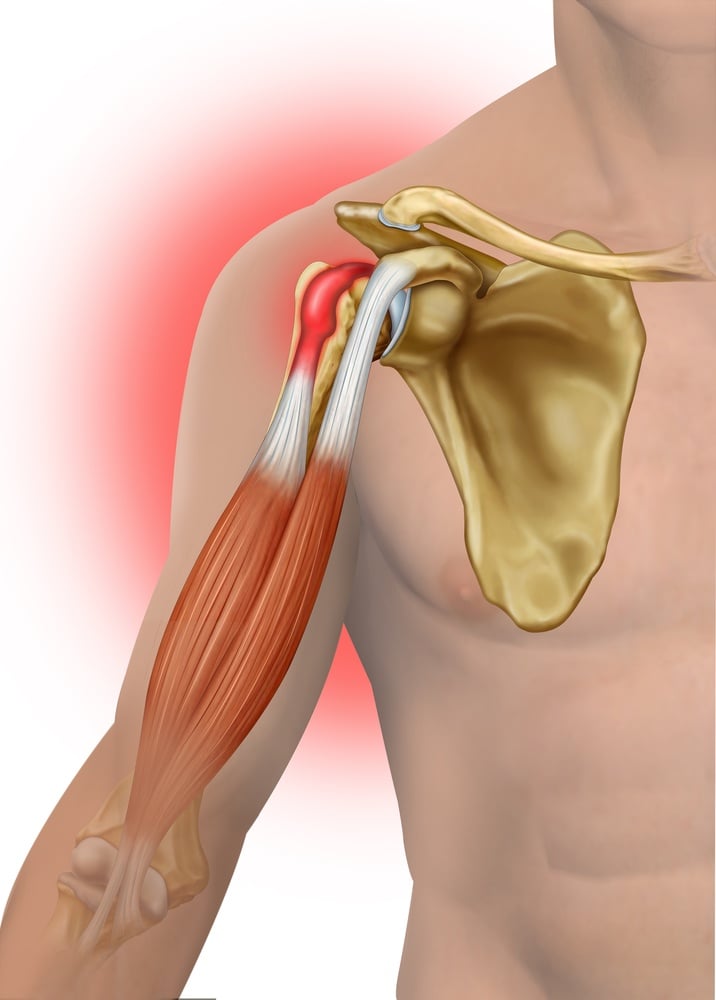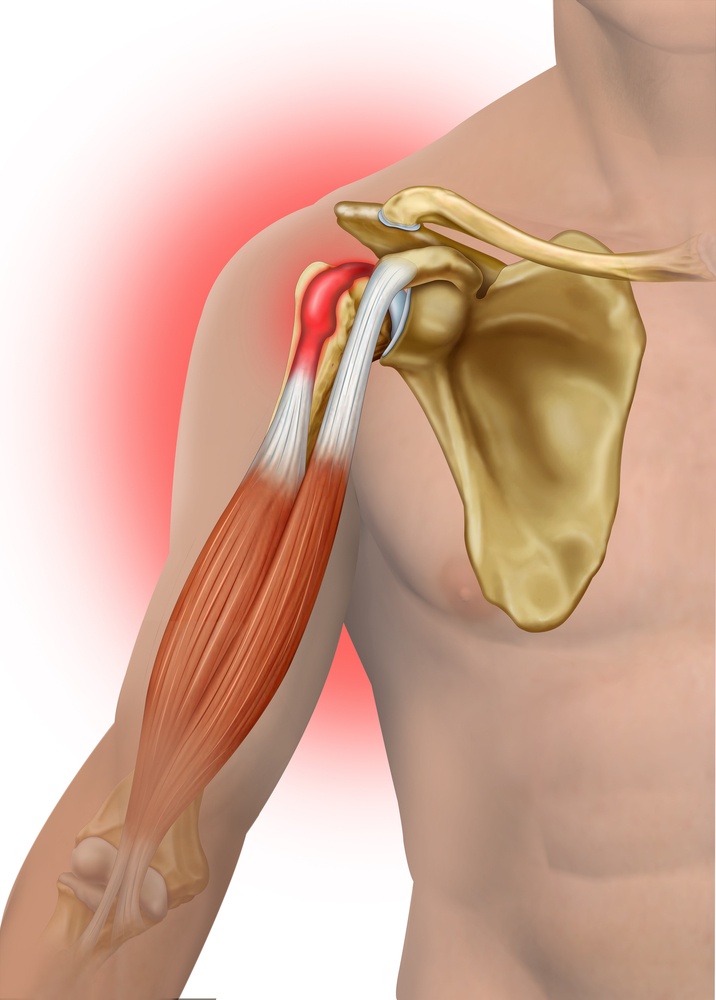Biceps Tendinitis: Causes and Risk Factors
October 17th, 2017 | 3 min. read


Shoulder pain can have many different causes. If you’re experiencing soreness or noticeable weakness at the front of your shoulder, it’s possible you have tendinitis (sometimes spelled “tendonitis”) affecting the long head of the biceps tendon—where the biceps muscle attaches to bone.
Quite often, this wear-and-tear injury is associated with other types of shoulder damage, like chronic instability, a rotator cuff injury, or shoulder impingement. If you have symptoms that point to biceps tendonitis, it’s best to see an orthopedist for a full exam and diagnosis, to gauge precisely what’s going on in your shoulder.
What Is Biceps Tendinitis?
Biceps tendinitis, like other forms of tendinitis, is marked by inflammation of the tendon tissue. This inflammation can lead to a thickening and swelling of the tendon sheath (the outer membrane containing the cord-like tendon fibers). Tenderness and soreness may result.
These changes in the tendon’s shape may also affect the mechanics of the shoulder joint, leading to a popping or snapping when you lift your arm above your head or otherwise use the joint.
Other symptoms of biceps tendonitis include:
- Soreness or aches that radiate down the length of the upper arm
- Increased pain with overhand motions (like serving a tennis ball or painting a wall) or when lifting items overhead (e.g., airplane carry-on bags).
Where Is The Biceps Tendon?
The biceps muscle attaches to the bones of the arm in two places: at the shoulder and at the elbow.
In most cases, biceps tendonitis refers to irritation and inflammation of the tendon at the upper end of the muscle, at the shoulder. Here, two separate biceps tendons—the short head and the long head—branch off from the muscle and attach to bone at two places in the shoulder:
- The coracoid process. The “short head” of the biceps tendon attaches the back of the upper biceps to a bony protrusion on the shoulder blade (in your upper back). This attachment point plays a role in your arm’s ability to swing across the body and out to the side. Here, the biceps and the biceps tendon also stabilize the shoulder when you lift something heavy.
- The glenoid. The “long head” of the biceps tendon attaches the front of the upper biceps to the top of your shoulder socket. This attachment point helps to stabilize the shoulder by keeping the ball of your humerus inside the socket of the shoulder joint. If tendonitis turns into a full tear at the long head, you may have general biceps weakness, along with trouble rotating your upper arm (palm up or palm down).
Together, these two biceps attachment points firmly secure the muscle to the bone, allowing you to flex your arm (bend it at the elbow), rotate your forearm (palm in vs. palm out), and swing your arm out to the side or across your body.
Most cases of upper biceps tendonitis affect the long head of the biceps tendon, where the muscle attaches to the anterior, or front, of the shoulder. The long head is more likely to suffer damage due to its location, crossing in front of the ball-and-socket joint. Thus any injury affecting the shoulder, such as a forceful dislocation, can put tension on the tendon, leading to irritation or tears.
Do You Suspect You Have Biceps tendonitis?
Click the link below to book an appointment today to get some relief.
Causes of Biceps Tendinitis
What causes biceps tendonitis?
- Normal wear and tear. Most of the time, biceps tendonitis is an age-related wear-and-tear condition. As we get older, the collagen in our tendons begins to break down and become less elastic—more subject to irritation, fraying, and ruptures.
- Repetitive motions using the shoulder and arm can hasten or worsen damage that might have happened anyway. Athletes may be vulnerable to biceps tendonitis due to overuse and over-straining the tendons when moving the arm with force or when lifting heavy weights. Overhand motions are often to blame: for example, serving a tennis ball, playing handball, swinging from bars or ropes (hello, Crossfit!), throwing a baseball, or swimming the crawl.
Risk Factors for Biceps Tendonitis
Though anyone can develop biceps tendinitis, you are in a higher risk category if you meet the following criteria:
- Age (30+). All forms of tendinitis are more likely as we get older, due to normal age-related wear and tear.
- Other shoulder damage. Osteoarthritis of the shoulder, shoulder impingement, SLAP lesion tears, rotator cuff injuries, frequent dislocations or instability, inflammation of the lining of the shoulder socket—these sometimes accompany tendonitis or make its occurrence more likely.
- Athletics or occupation. Frequent, repetitive use of the shoulder, especially overhand motions or lifting heavy items overhead, can increase your risk.
- Smoking has been associated with an increased risk of tendon damage and rupture, along with slower healing due to poor circulation.
- Being significantly overweight may make you more likely to experience collagen breakdown.
Why See a Doctor for biceps tendonitis?
Getting a diagnosis of tendonitis is important. A nagging pain and weakness may feel like something you can ignore and “push through,” but know that biceps tendonitis, if it progresses to frays and a more significant breakdown of tissue, can lead to a partial or full rupture of the biceps tendon. This injury can lead to significant weakness and disability in the arm.
Full tendon tears cannot repair themselves; surgery would be needed to repair the torn tissue and reattach the biceps muscle to bone.
By seeing an orthopedist early, you can get a diagnosis and talk to your doctor about options for non-surgical, conservative treatment (usually a combination of rest and anti-inflammatory medications).
If you’re an athlete or depend on shoulder and arm strength for your occupation, surgery to diagnose and repair damaged tendon tissue may also be an option.
Please call Coastal Orthopedics in Corpus Christi, Texas if you believe you might have biceps tendonits and are in need of care at (361) 994-1166 today!
Article written by: Rob Williams, MD
Dr. Williams has been practicing orthopedic surgery in Corpus Christi since 1998. After graduating from Texas Tech hereceived his medical degree from the University of Texas at San Antonio. At the prestigious Campbell Clinic located at the University of Tennessee, Dr. Williams completed not only an Orthopedic Surgery Residency, but an additional year of Fellowship Training in Spine Surgery. Dr. Williams is dedicated to creating an excellent patient experience in the office or in the surgery suite.
Topics:


